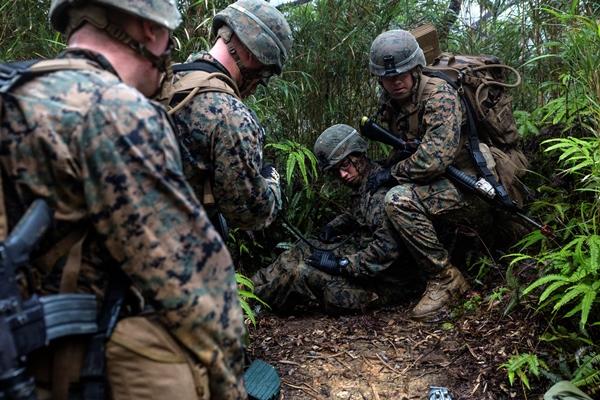Got trench foot?
The Marine Corps is counting on honest feedback from troops who will wear and test four different tropical combat boot prototypes this summer at the Marines' Jungle Warfare Training Center in Okinawa, Japan.
Officials with Marine Corps Systems Command told Military.com that about 400 Marines from the Hawaii-based 3rd Marine Regiment would test out the boots during a two-to-three week period of jungle combat training that will start within the next two months.
The Marines published a call for sources to design the tropical combat boot last December, in response to an earlier directive from the commandant, Gen. Robert Neller.
"The commandant was interested in pursuing the opportunity to provide Marines with boots that would be lightweight, fast-drying, and appropriate for a tropical environment," said Lt. Col. Rob Bailey, product manager for infantry combat equipment for the command. "We also know that the Army has a similar interest in coordinating and collaborating."
Marine Corps Systems Command hosted an industry day in January to solicit manufacturers who might be capable of building an acceptable boot. In May, the Marine Corps awarded contracts to four manufacturers -- Original Footwear, Bates Footwear, Belleville Boot Company, and Rocky Boots -- to create boots acceptable for the wear test.
Each company is contributing 100 pairs of boots that will all go through the same rigorous wear in the jungle and back in garrison during the training period.
"We're looking at mud retention on the soles of the boots: do they feel soles will be self cleaning, do they have adequate traction and mobility in tropical environment. Did it have ankle support and foot support, was it sufficiently fast drying, was it durable, did it hold up under weather conditions," Bailey said. "We'll also have open ended questions."
He added that the weight of the boot will also be a key factor.
According to earlier contracting documents, the boots must weigh less than 2.3 pounds per pair, and ideally less than 1.7 pounds. They have to stand six to nine inches high and maintain ankle stability, and come in either "coyote" or "olive mojave" colors.
The sources-sought solicitation encouraged manufacturers to use synthetic leathers and fabrics that would dry quickly, and materials that would wear well over time.
Following the jungle testing, Marines will take written surveys to evaluate the quality of their boots and how well they held up to mud and moisture. The boots will then be sent back to SYCOM, where officials will observe them for wear and tear and durability.
That feedback will then be used to create a list of specifications for the creation of a boot that any Marine might someday be able to buy from the base exchange, Bailey said. When the specifications are finally released, he said, any manufacturer will be able to compete for the contract, not just the four that participated in the initial wear test.
Currently, Bailey said, the tropical combat boot is being designed as a commercially available piece of gear that Marines may purchase, rather than an issued uniform item. Regardless, he said, officials will have to obtain clearance from the Marine Corps uniform board for Marines to wear the boots with their utility uniforms. He expects that application process to happen in the first half of next year.
Despite all the steps that need to take place, Bailey said he expected the process of creating the end product to move fairly quickly.
"On a notional timeline, we feel like we'll be complete with the specification in the first quarter of 2017 and have boots available any time after the second quarter," he said.
While Marines don't operate in the jungle as frequently as they once did, this gear, he said, will help ensure they are best prepared when they do.
"I think the commandant's intent was just to ensure we're providing options to Marines in every environment they could be operating in worldwide," Bailey said.
--Hope Hodge Seck can be reached at hope.seck@military.com. Follow her on Twitter at @HopeSeck.

























